On Cooking With Gas
post by Zvi · 2023-01-13T14:20:00.613Z · LW · GW · 60 commentsContents
Gaslighting and its Discontents None 60 comments
Research meta-analysis says gas stoves give off unsafe N02 levels and increase risk of childhood asthma by 34% and are responsible for 12.7% of childhood asthma.
None of this is new. The way safety panic works is that you focus on a particular risk this week and an attempt is made to make everyone’s life worse in its name.
Emily Oster takes a deeper dive on the original studies. She is not impressed.
For the most part, the other papers in the meta-analysis have similar features. They tend to show positive correlations between asthma and gas stove exposure, but the effects are a bit noisy and they do not necessarily paint a consistent picture. A 2013 paper finds, for example, a link with asthma for girls but not boys, and no links with other respiratory issues.
What to take from this? We know that gas stoves emit nitrogen oxides and that, in general, those are not good. We know that air pollution, in general, is bad for respiratory symptoms, including asthma. So it seems very plausible that there is some link here. However: the magnitude is likely small. In most of the estimates, it’s small. And, beyond that, we do not see the kind of smoking gun in any of these data that would suggest a really consistent link.
Another way to put this is that there are clearly many, many factors other than gas stoves that explain asthma. Some of these may also be environmental. But I’m skeptical that gas stoves play a huge role, as would be suggested by the new paper.
The link on the state-wide level runs the other way.
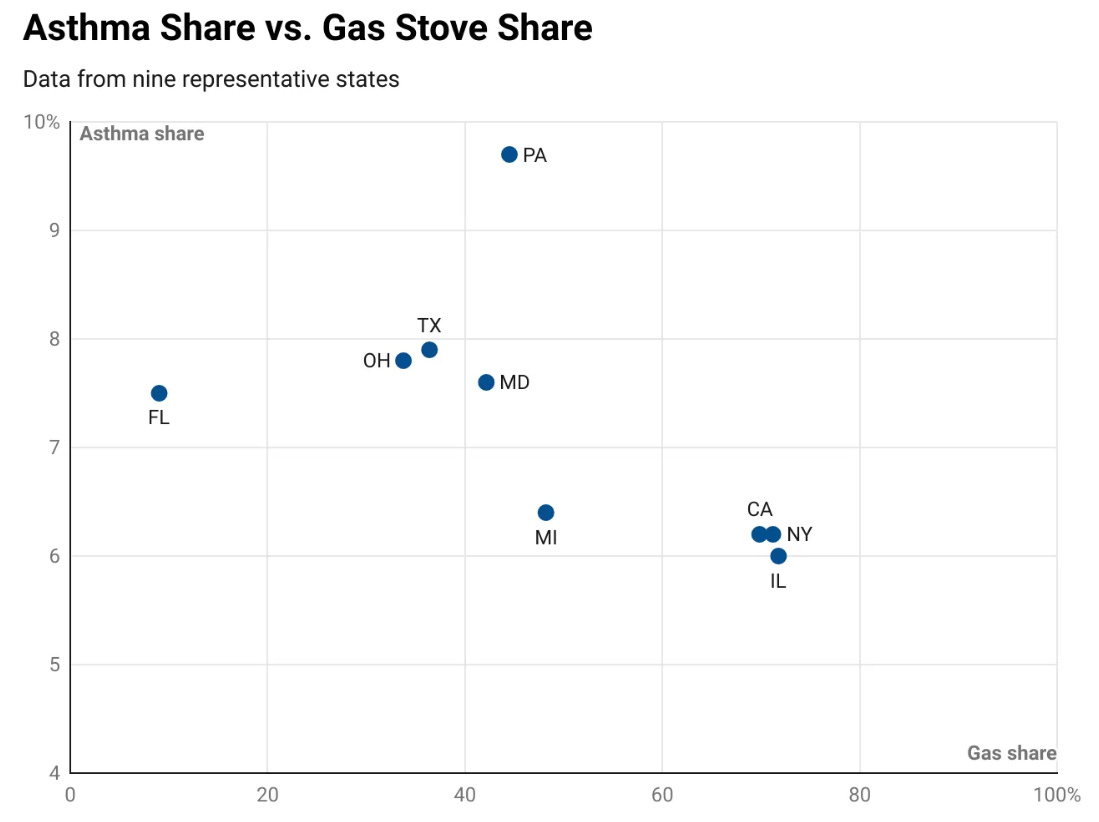
I am confident gas stoves do not prevent asthma because physics. One still notes that if this graph had been reversed it would be part of the case to ban such stoves.
One explanation for the reversed correlation is that gas stoves cost more and positively correlate with income. This also suggests they are a superior good. Rich people choose to cook with gas. The spike at the top of the income distribution supports this. As does 80% of restaurants, who care the most about quality, choosing gas stoves, versus 40% of households. Alternatively, some of this could be because richer people live in older and more expensive buildings that happen to have gas stoves. If new construction is restricted in the most expensive areas, and old construction has more gas stoves, that could create this effect as well.
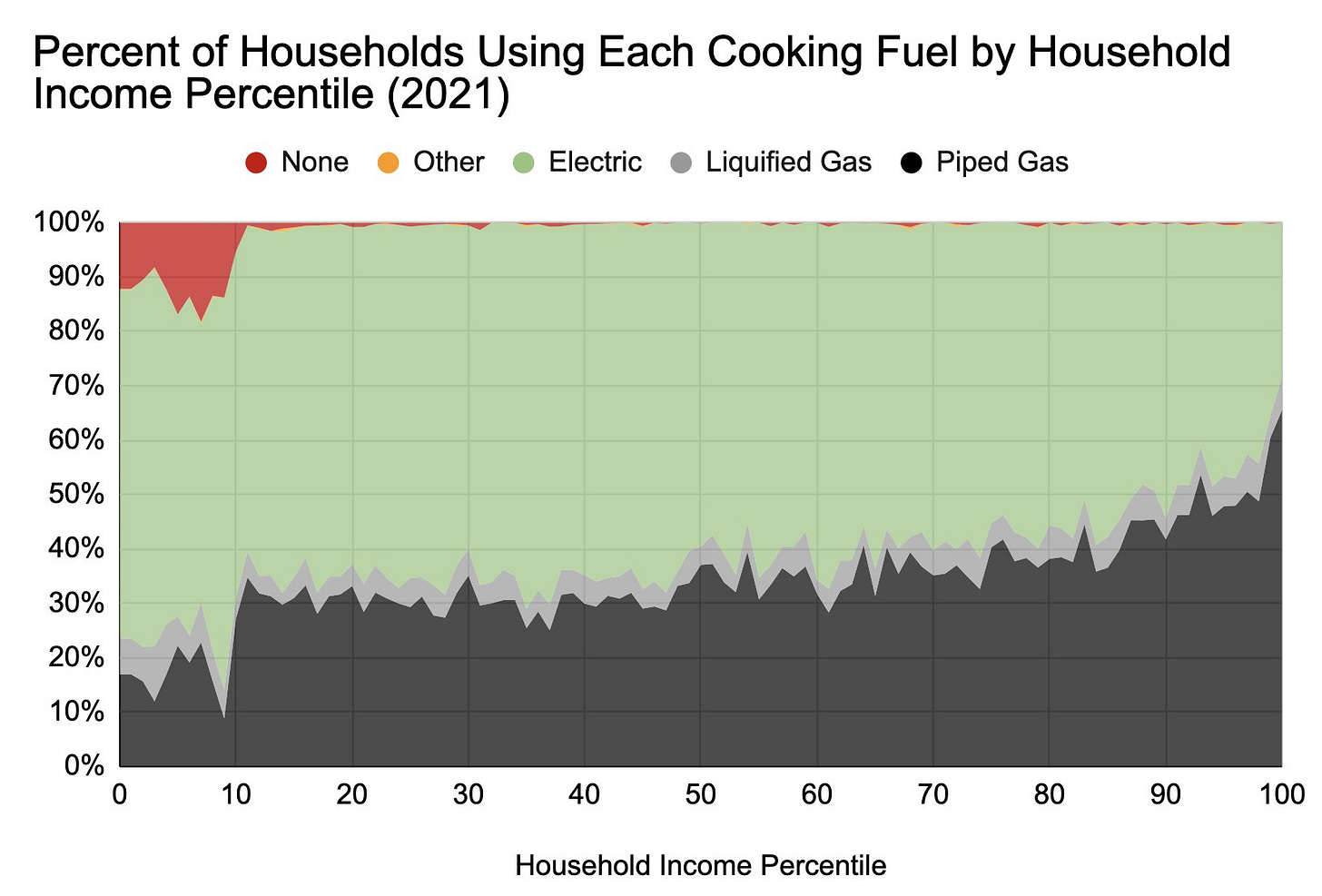
Emily’s practical advice seems solid, if one is concerned:
Can I do anything now?
Assuming you are not replacing your gas stove now, is there anything you can do?
Yes.
First, run the hood fan on your stove when you use it. It’s not clear how much this matters, but on the margin it should help.
Second, use a HEPA filter with an activated carbon filter. At least one study showed that installing such a filter in the kitchen lowered nitrogen dioxide levels by half as much as replacing the stove. This is a lot more effective in the data than the hood fan.
As for me, even if the full effect in the meta-analysis was real? I. Do. Not. Care.
There is a reason the expression ‘now you’re cooking with gas’ stuck. Electric stoves are not good. Gas stoves are a Nice Thing.
You can attempt to pry my nice thing from my future no longer functioning asthmatic hands. I am so done with taking the Nice Things in life and ruining them in the name of marginally better health. They also increase resiliency in a blackout.
We had an electric stove in Warwick. We adapted, but it was clearly worse. Neither me nor my wife ever fully adjusted, and she grew up with an electric stove. I have been in otherwise quite nice Airbnbs with electric stoves so slow and terrible that they made me not want to cook breakfast. I have yet to see a good one.
There are those who disagree with my cooking preference for gas stoves. They say that no, you are thinking of the crappy old style electric stoves. That the new electric stoves are super awesome. To which I say, I am happy to disagree, and they can have an electric stove if they so desire.
Gaslighting and its Discontents
There are already many places where it is not permitted to put gas stoves in new construction. They become ancient artifacts or rare treasures, like fully flushing toilets and full pressure shower heads.
Some of the usual suspects are of course doing the obvious, and calling on us to ban such stoves more broadly. This is an ongoing effort. Here’s Mother Jones last year calling for a ban and saying gas stoves are a fossil fuel industry conspiracy that must be stopped. Here’s Vox from 2020 talking about how horribly dangerous they are and Something Must Be Done, with the poor being ‘most at risk’ from gas stoves despite being much less likely to have one.
Here is Matt Bruenig saying that there renters living in 15 million apartments with gas stoves, ‘something they have no control over.’ And that there is a good case that landlords that are violating habitability standards. At the same time, he links to his own article that is entitled ‘The Gas Stove Problem,’ saying with a straight face ‘the agency was researching the issue and looking for ways to address the problem, but that they are not looking to ban gas stoves.’ Matt’s been trying to get gas stoves banned for years.
I can see an argument that someone ‘has no choice’ if the landlord replaced an electric stove with a gas stove. When choosing where to rent, one absolutely has a choice. We made it a point to ensure our apartment had a gas stove, both when renting and when buying.
Part of the motivation here is climate-related and the general hatred of nice things, part is the usual suspects hate fossil fuels and gas companies, part is safety obsession.


On the contrary. The gaslighting has already begun.

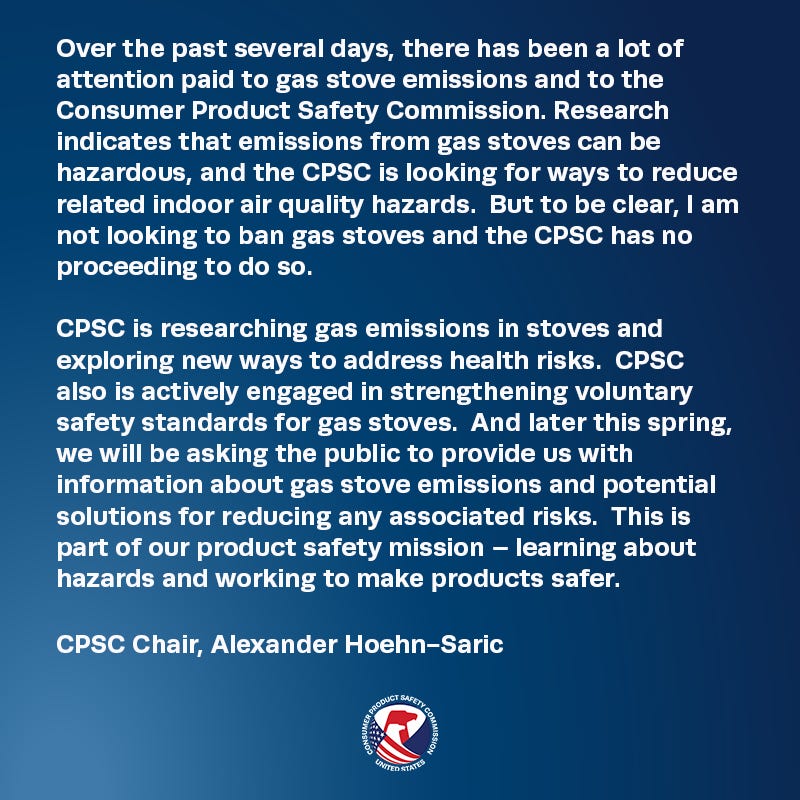
‘We will be asking the public… potential ‘solutions’ for reducing any associated risks.’
That is exactly what you say when you are going to look to ban something.
‘Has no proceeding to do so.’
No, not yet. That comes later. Notice the lack of any future tense.
Also, as this Bon Appetit post on the subject informs us, the line before that was:
“Any option is on the table,” [US Consumer Product Safety Commissioner] Trumka said. “Products that can’t be made safe can be banned.”
And these are not the phrasings you use when you’re not trying to get a ban passed:



Here’s how Bloomberg interpreted what the CPSC is doing.

A federal agency says a ban on gas stoves is on the table amid rising concern about harmful indoor air pollutants emitted by the appliances.
Yep.
Which was brought to my attention by, because why not, Senator Joe Manchin.


The replies, of course, include a number of people supporting banning gas stoves.
I would not underestimate the political impact of such efforts. It sticks with you. It is striking how many people on Twitter are saying ‘gas stoves for life.’ Scott Sumner idly wonders (in what is otherwise a post about life expectancy) if those considering a ban ‘are working for Trump’ and speculates a ban would shift Asian Americans to the GOP.
Even worse, the President is officially denying it.

The ‘Inflation Reduction Act’ included a subsidy for switching to electric stoves. That is indeed the correct way to price in an externality or express a preference. It also indicates that yes, there is an ongoing effort to get rid of gas stoves, that may escalate.
I do have to admit, this was a pretty sick burn.
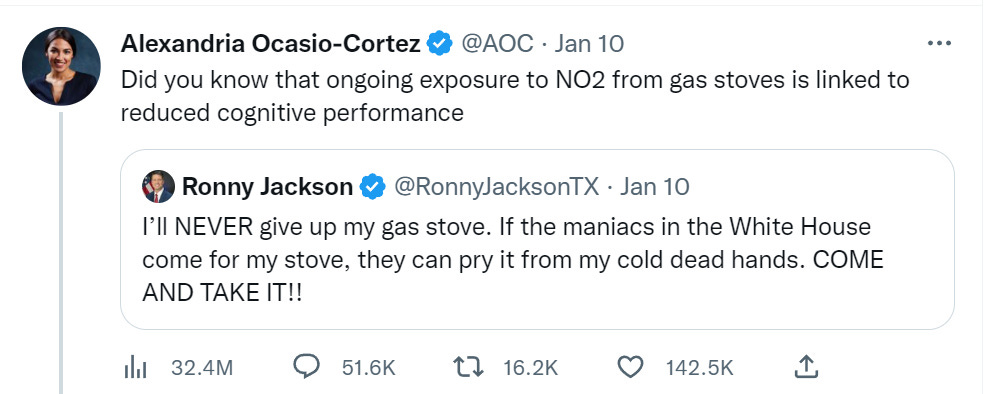
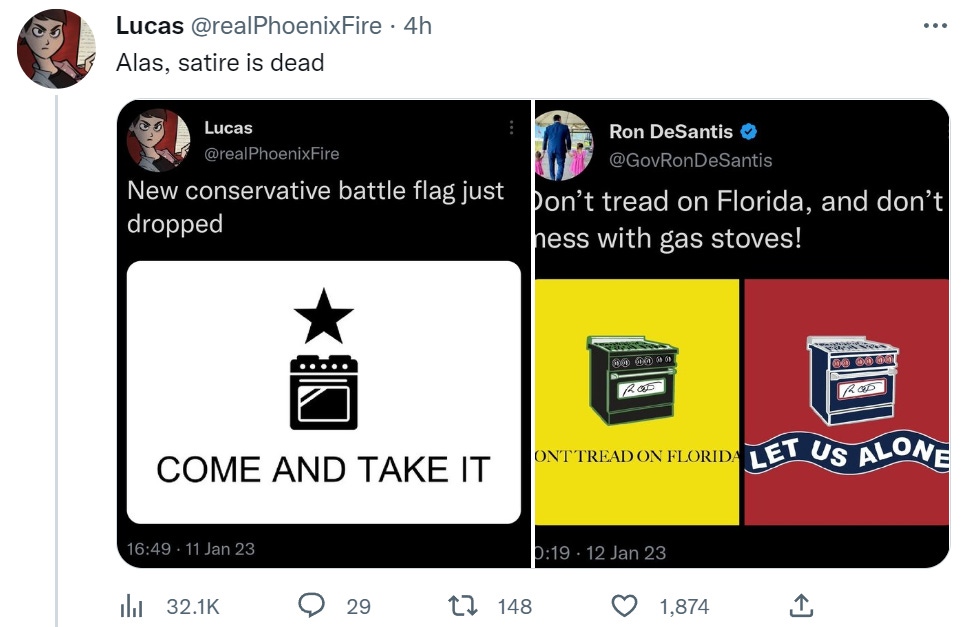

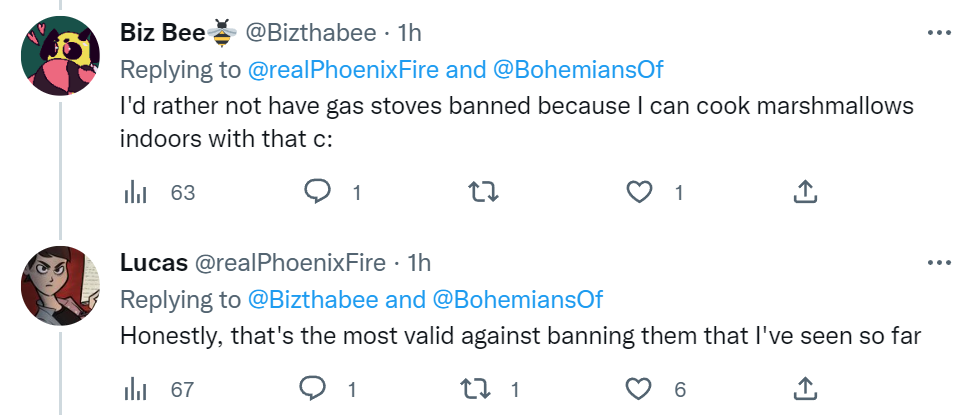
That’s how this kind of logic works, you need a good excuse not to ban things.
Even among my Twitter followers, quite a few want to ban gas stoves, with a strong partisan effect.
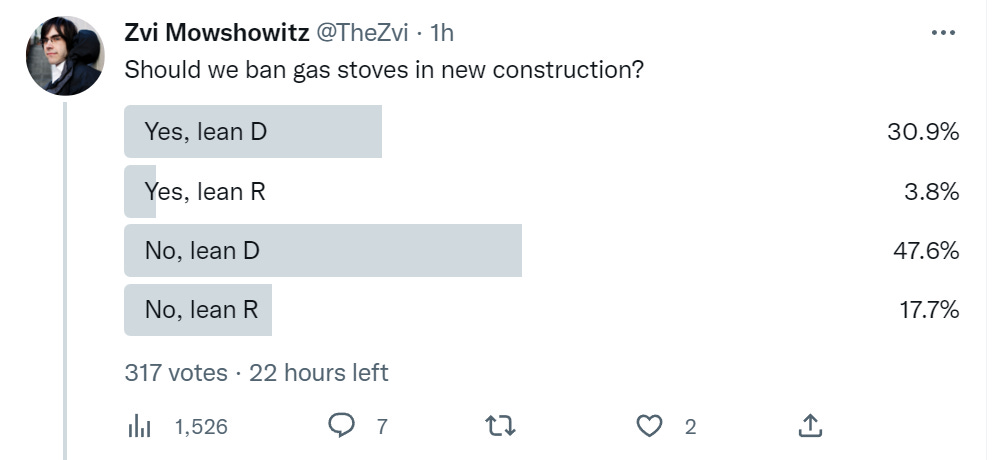
None of that means any regulatory action will end up happening. My guess is it won’t any time soon given the degree of backlash. Early trading on my prediction market says it is an underdog to happen by 2026, down to 20% as I type this which makes my estimate of true value somewhat lower. It would be a heavy lift on the federal level. Often such fires go out in time. If we are lucky we will never hear anything about this again. But so far no one is willing to come out and say this is anything like a Can’t Happen.
It is often difficult to tell the difference between ‘this was a crazy person who warned and fought against a phantom’ and ‘this was a hero who stopped a disaster and now you are calling them crazy and cutting their budget because it worked.’ We will never know how much of this was Column A versus Column B.
What makes this all extra weird is that it looks like gas stoves are very much a blue state phenomenon somehow. Illinois makes this not appear to be primarily about logistics.
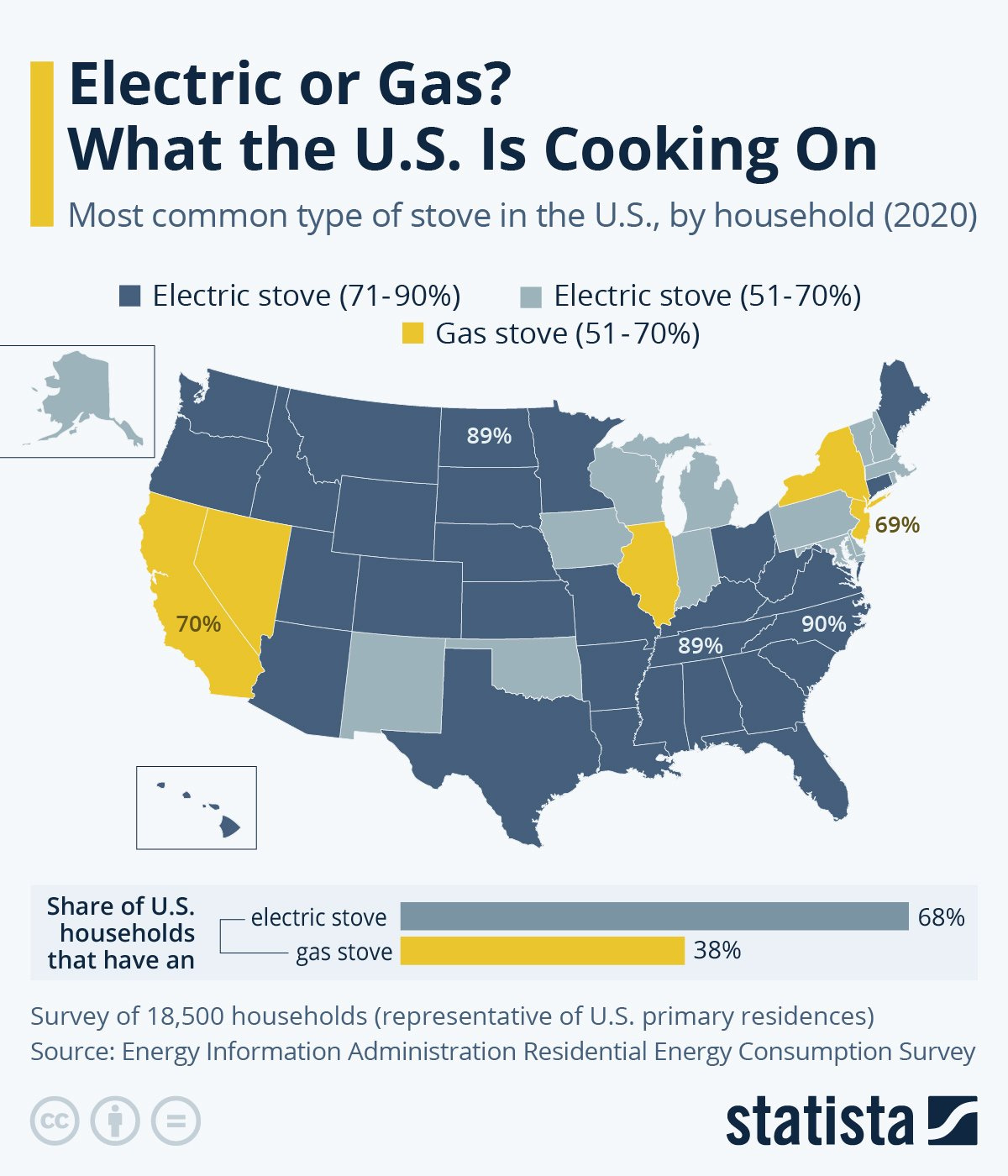
The partisan stats back this up.
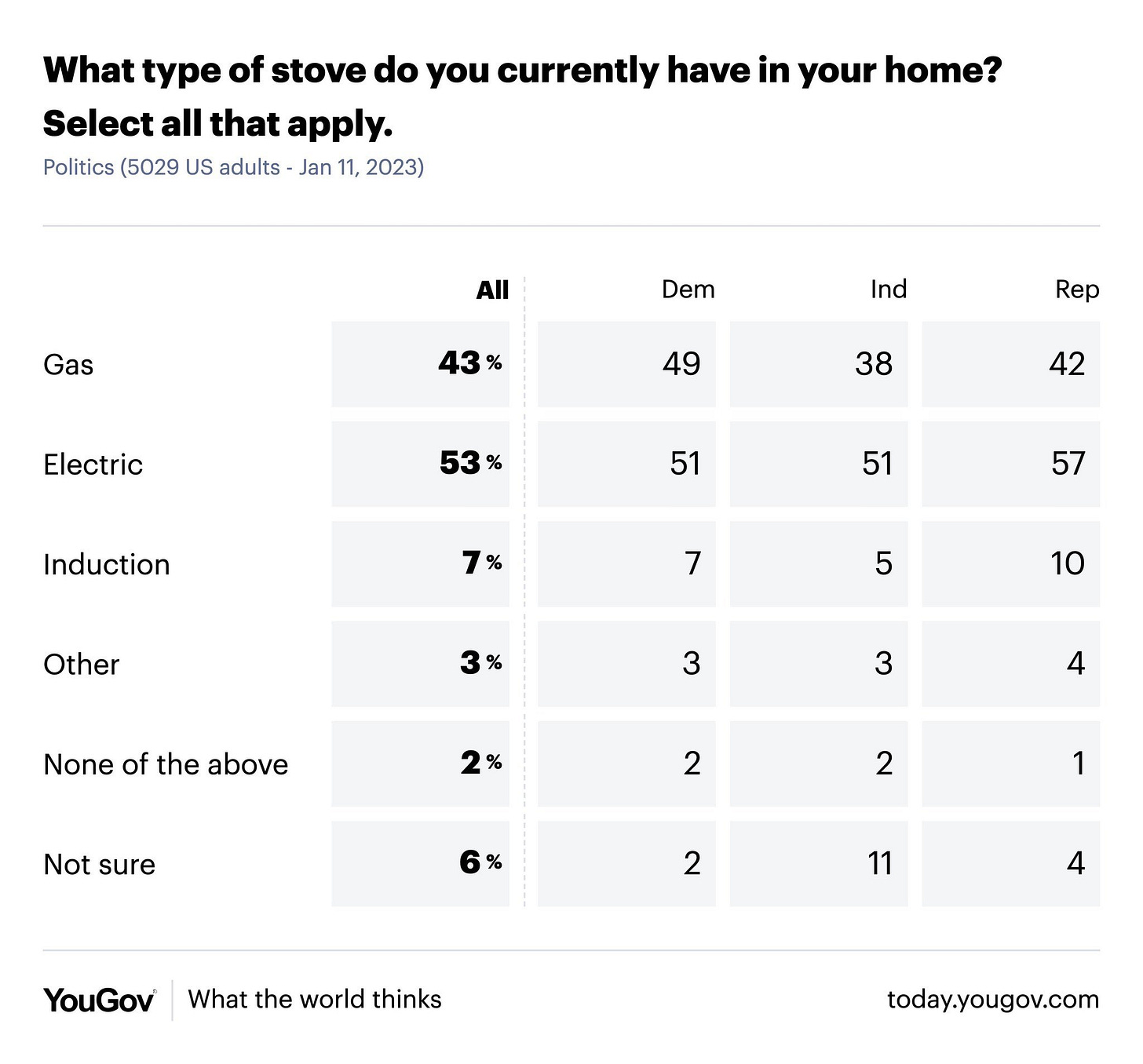
11% of independents are ‘not sure’ what kind of stove they have. Or of anything, really.
Also, there’s a safety case going the other way (article link).

Households that use electric ranges have a higher risk of cooking fires and associated losses than those using gas ranges. Although 60 percent of households cook with electricity four out of five (80 percent) ranges or cooktops involved in reported cooking fires were powered by electricity. Population-based risks are shown below,
• The rate of reported fires per million households was 2.6 times higher with electric ranges.
• The civilian fire death rate per million households was 3.4 times higher with electric ranges.
• The civilian fire injury rate per million households was 4.8 times higher with electric ranges than in households using gas ranges.
• The average fire dollar loss per household was 3.8 times higher in households with electric ranges.
(There is also a climate case to made in either direction, depending on where the marginal electricity is coming from, since often, as in Europe, the answer is ‘coal’ which is way worse than a gas stove.)
Those are very large percent increases, although the base rate is not so high. I do not see anyone talking about base rates here, or in most other ‘safety’ or ‘think of the children’ debates. I am guessing the actual level of harm has little to do with who decides to frame this in which fashion.
In summary:
- The gas stoves unsafe claim looks overblown.
- Gas stoves remain great.
- Yes the usual suspects are collectively (aka ‘they’) are looking to ban gas stoves.
- No they probably won’t be able to ban gas stoves soon, at least federally.
60 comments
Comments sorted by top scores.
comment by [deleted] · 2023-01-13T23:08:01.552Z · LW(p) · GW(p)
Zvi have you actually tried induction? They have completely different and favorable properties.
You can buy an induction burner off Amazon for a paltry $50-$100.
They are the choice of rich people for new builds.
The inverse argument is that we know burning things indoors is bad, per the same physics you cited. It's hard to tell HOW bad - some have argued that secondhand smoke if you live with someone 40 years who smokes right next to you "only" reduces your expected lifespan about a year - but it's still bad.
And we know the stoves and plumbing also leak methane, which causes a lot of the warming, and they are a general fire hazard. Banning the stoves and gas supplies to homes would force everyone to switch to the superior alternatives...
Replies from: Huluk, jesper-norregaard-sorensen↑ comment by Huluk · 2023-01-14T07:02:24.909Z · LW(p) · GW(p)
Agreed with all of this, except the last sentence. Induction is superior, so let people learn of that and switch to it on their own time.
Also note that many cheap induction burners aren't particularly great. They tend more towards making annoying noises, for one. You only get the full induction experience with the high quality equipment which puts you back a few k.
Replies from: None↑ comment by [deleted] · 2023-01-14T19:33:52.231Z · LW(p) · GW(p)
https://www.nytimes.com/wirecutter/reviews/best-portable-induction-cooktop/
Depends I guess on your level of induction snobbishness, but wirecutter got good results with cheap models. It's also relative - compared to what. This whole OP is about a gas stove, where you just kinda look at the flame and estimate how much heat it's producing. Induction at least you can set a precise numerical value.
↑ comment by JNS (jesper-norregaard-sorensen) · 2023-01-14T14:10:05.566Z · LW(p) · GW(p)
We switched to induction a couple of years ago, something that is built into the counter top with 4 "burners".
And I have to say, it is fantastic, the speed is on par with gas, the control you get is also on par with gas.
Also if people are really worried about the air quality in their home, they really shouldn't use candles or a laser printer.
The amount of particulates from those is just insane (where I live it is illegal to have a laser printer in the office, it has to be in a separate closed room - and if it is extensively used, the room has to have point exhaust)
Replies from: None, SaidAchmiz↑ comment by [deleted] · 2023-01-14T19:32:10.755Z · LW(p) · GW(p)
Oh damn. Yeah I didn't know about the laser printer emissions at all. I just have one in a common area where I live for the occasional print. I do spend most of my time in a room with a HEPA filter though.
(because particular pollution apparently has very high mortality rates, it seems like a smart thing to always be filtering the air in your most commonly occupied rooms. Just to be on the safe side, since effective filters are cheap.)
↑ comment by Said Achmiz (SaidAchmiz) · 2023-01-14T15:59:06.615Z · LW(p) · GW(p)
(where I live it is illegal to have a laser printer in the office, it has to be in a separate closed room—and if it is extensively used, the room has to have point exhaust)
Wow! Where is this?
Replies from: jesper-norregaard-sorensen↑ comment by JNS (jesper-norregaard-sorensen) · 2023-01-15T08:50:57.959Z · LW(p) · GW(p)
Denmark.
comment by Thomas Sepulchre · 2023-01-13T23:07:21.941Z · LW(p) · GW(p)
(There is also a climate case to made in either direction, depending on where the marginal electricity is coming from, since often, as in Europe, the answer is ‘coal’ which is way worse than a gas stove.)
I don't believe this is true, that is, I don't believe that, in Europe, often, the marginal electricity is coming from coal. Of course this depends on what often means.
Digging into this question isn't easy, but I found a few things
- Coal produced about 15% of the electricity in the EU in 2020, and the trend is going down. This is obviously not an indication of the marginal electricity source.
- Within the EU, 13 of the 27 member states do not have a single coal plant.
- Even when coal plants are running, this doesn't mean that coal is the marginal source of electricity. Electricity from gas is more expensive, therefore whenever a gas plant is running, gas is the marginal source of electricity.
- I found this paper computing the marginal electricity source in Spain (see figure 2), between 2015 and 2021. Coal is the marginal source of electricity only a few percents of the time.
- I also found this paper computing the marginal electricity source in the EU as a whole in 2010 (see figure 1b). Back then, coal was the marginal source of electricity slightly below 60% of the time. Given that this was 13 years ago, this number must be lower now, how much though I don't know.
This doesn't undermine your points. Indeed:
- Coal is a dirty source of electricity, dirtier than gas and basically everything else.
- If we want to discuss the climate implications of gas stove vs electric stove, we should take into account the climate implications of the marginal production of electricity.
- If the marginal electricity source on the grid is gas, the advantage of using an electric stove isn't obvious.
↑ comment by [deleted] · 2023-01-14T06:04:20.959Z · LW(p) · GW(p)
A significant fraction of the climate impact of gas is actually ubiquitous fugitive leaks rather than the CO2 produced, as several percent is lost somewhere between production and final combustion or while appliances are turned off. Multiplied by a greenhouse effect dozens of times as strong as the CO2 it combusts into, that builds up.
It is at least theoretically conceivable if the parameters were just right that the same gas running through fewer, shorter, larger pipes with a lot less leakage to centralized power plants driving electric heating could actually produce less impact per unit useful work (especially given that gas heat has a smaller fraction of the heat actually go into the thing being heated). I am utterly unprepared to do numbers on this though and this would be completely dependent on actual leakages and where they occur and the difference in the fraction of useful work.
comment by willir29 · 2023-01-14T00:53:24.672Z · LW(p) · GW(p)
I would agree with many commenters here about induction stovetops.
I used to have one, living in Russia, and now I have a gas one in the US (wasn't much choice here TBH). The induction was clearly superior. It cooked faster, had a timer, and was much easier to clean.
I should add that I had the cheapest induction one we could find back then.
However, banning gas stoves, and even talking about banning them, is clearly stupid now. We shouldn't ban stuff willy-nilly. We should have an extremely high bar to ban anything, not like "Hey somewhat had a paper that probably says something is somewhat dangerous".
I guess eventually, gas stoves would need to be priced out, or something, though. Once a majority of our electricity comes out of renewables.
P.S. I do agree that those old electric stovetops are just awful. I don't understand how come so many places still have them. And I did see good electric (non-induction) stove tops that have reasonable response time and can boil water faster than gas ones. Not sure how come you don't have them everywhere. Are they that new? I wanna see some explanation here. Because I'm confused!
Replies from: None↑ comment by [deleted] · 2023-01-15T04:50:26.866Z · LW(p) · GW(p)
I wasn't aware that improved electric stovetops existed. Every example I have seen simply uses an exposed electric element, with variation only on size. The elements get easily hot enough to set fire to paper, and are a significant burn hazard. They also have a crevice underneath that will accumulate very difficult to clean grease stains and carbon buildup.
There are a type that use a glass surface with the elements underneath - where I live now has them - but these perform even worse. They have to reduce power to prevent from overheating the glass, so they are the slowest form of cooking I have ever seen. And there still is a burn hazard, and the extremely hot glass solidified buildups.
Replies from: willir29↑ comment by willir29 · 2023-01-16T13:51:59.804Z · LW(p) · GW(p)
The new electric stovetop I tried were with glass/ceramic/whatever on top, and they didn't feel too slow. I didn't have that at home, so I don't have a lot of experience with it, but I got an impression that it was quite usable. The info about electric being faster to boil came from YouTube videos, so I could be mistaken. I assume they are mostly talking about medium to small pots, since on them gas are far less efficient. Here is one vid: https://youtu.be/CcAJ3_-Hou8 (timestamp: 1:05 ). P.S. I also googled some videos where gas got water boiling faster than electric, though they used a large pot. Would like to see that test on a medium pot.
If you have a glass top, would it matter if it solidifies buildup, it should still be easy to clean (on an even surface), comparing to gas stovetop?
I agree that electric with open coil should be nightmare to clean. Probably worse than gas.
I could see why electric stovetop might be a fire hazard. I'm not sure why bigger than gas though, maybe because it keeps being hot for a bit. Does it stays hot enough to set paper on fire quite long?
Replies from: None↑ comment by [deleted] · 2023-01-16T20:26:05.542Z · LW(p) · GW(p)
As near as I could tell, the glass type are either slower, or at worst they can't be faster than the naked coil electric type.
Yes, electric stoves are actually faster than boil water than gas. Their biggest problem is there is lag - there is thermal mass in the element, so there is a delay between changing the power level and the system responding. Gas and induction heaters have less lag.
The glass has less buildup than the open coil electric type or gas burner type, but more buildup than induction because the glass gets much hotter.
Gas is probably the worst fire hazard, but electric still is a fire hazard. Induction has the least fire hazard.
Replies from: willir29comment by [deleted] · 2023-01-13T23:16:47.832Z · LW(p) · GW(p)
Zvi this argument appears symmetrical to any other big government efficiency requirements.
Induction stoves are more efficient, both in energy usage and in their safety profile. (no open flame, none of these combustion emissions, no chance of leaked methane leading to a fire or explosion).
LED bulbs are vastly more efficient.
Some air conditioner models are vastly more efficient.
Despite this, stupid individuals and greedy landlords will always purchase the cheapest product sold or what they are used to using. So you have to literally make gas stoves, incandescent bulbs, and inefficient air conditioners illegal to be sold if they are below some empirical standard.
This works. It also drives market share to the superior product which gets cost reduced until it's often offered at a superior price point in terms of total cost than the product it replaced. (example: LED bulbs are a couple dollars but are so much more efficient than incandescent they pay for themselves within a few months and theoretically last for decades)
This seems like a win/win use of government power. The only losers are people who make up uninformed and ignorant objections like the one you just posted. (not that improved products don't have tradeoffs, they do. )
↑ comment by Radford Neal · 2023-01-15T15:53:07.587Z · LW(p) · GW(p)
"LED bulbs.... theoretically last for decades"
Yeah, "theoretically". In practice, many LED bulbs last only days or months.
It was the same with compact fluorescent bulbs, which were the initial (forcibly promoted) replacement for incandescent bulbs, but which have now been abandoned due to shorter-than-advertised lifetime, bad light quality, and presence of toxic waste.
Maybe it's better to let new technologies replace old technologies when, and only when, they are actually better, and hence need no force to be adopted?
Replies from: None↑ comment by [deleted] · 2023-01-15T21:40:16.542Z · LW(p) · GW(p)
Who should decide if they are actually better.
Individual consumers who go by anecdote like you mentioned and have no possible way to know the truth?
Or someone armed with the actual statistics on this.
Replies from: Radford Neal↑ comment by Radford Neal · 2023-01-15T22:18:58.438Z · LW(p) · GW(p)
I installed a LED bulb just a week ago, which lasted about two days. I have had at least half a dozen other LED bulbs fail long before their advertised lifetime. I think I know the truth.
Replies from: None↑ comment by [deleted] · 2023-01-16T18:43:59.329Z · LW(p) · GW(p)
Neal, you probably know about representative samples and small n and all the rest.
You aren't wrong that LED bulbs can fail drastically before their advertised lifetimes. This is because the LEDs do last what it says on the box, but there are voltage conversion parts in the base of the bulb that vary widely in how long they last.
And if you manage to install a brand that did that part of the electrical engineering correct, the "truth" is you won't see them fail in your expected lifetime.
I believe this is called a 'gears level model'.
Replies from: Radford Neal↑ comment by Radford Neal · 2023-01-16T21:29:00.556Z · LW(p) · GW(p)
The n isn't that small. And it makes no difference whether it is the LED itself that fails, or the voltage conversion part - it's dead either way. And though it may be that some brands are better than others, the ability of a consumer to tell whether they've found a good one or not is part of a product reaching the level of maturity where it's actually a good idea to adopt it.
Replies from: None↑ comment by [deleted] · 2023-01-16T21:39:12.305Z · LW(p) · GW(p)
Your n is not statistically representative because you didn't purchase thousands of bulbs from the market from random manufacturers. Only an entity who did this can confidently make claims about actual average reliabilities. (which basically means government or a well funded non profit)
You cannot rationally have any confidence about your conclusions.
So you're saying that because some cheap brands of LEDs die early, while good brands don't, LEDs shouldn't have been made basically mandatory, with lighting efficiency standards that have gotten progressively tougher.
(initially the Federal standards made it where incandescents could not be sold, but halogens were still meeting the minimum standards, and they have gotten tougher from there)
Replies from: Radford Neal, Jonathan_Graehl↑ comment by Radford Neal · 2023-01-16T22:12:31.213Z · LW(p) · GW(p)
You have a naive level of trust in the ability of a superficially well-conducted study to arrive at a relevant conclusion. For starters, what exactly is meant by "bulbs from the market from random manufacturers"? And did governments actually conduct such studies before enacting regulations? How would that work, since the market was quite different after the regulations than before?
And while it may be that cheap LED bulbs die early, but some good (and expensive) ones don't, that isn't actionable information. I think you can imagine the result if consumers start preferring to buy whichever bulb is most expensive - formerly cheap and unreliable bulbs would soon become expensive and unreliable bulbs. Some sort of brand reputation is needed, but this process is probably inhibited by mandating that LED bulbs must be used.
I haven't tried to quantitatively assess the impact of these regulations (which would be difficult), but I have my doubts that they have resulted in consumers saving money, or using less electricity, or producing less CO2, once one looks at all impacts. That would include the impact of an entire industry for producing compact fluorescent bulbs being created and now largely abandoned. And perhaps the LED bulb industry will be abandoned in the end too - depending on whether the bulbs that are reliable turn out to be sufficiently costly that either the regulations are abandoned, or some other technology replaces them.
It seems like a classic example of Hayek's view that information needed to make good decisions is distributed amongst many parties, and can only be aggregated through the price mechanism in a free market, not by central planners.
Replies from: None↑ comment by [deleted] · 2023-01-18T06:31:37.873Z · LW(p) · GW(p)
I haven't tried to quantitatively assess the impact of these regulations (which would be difficult), but I have my doubts that they have resulted in consumers saving money, or using less electricity, or producing less CO2, once one looks at all impacts. That would include the impact of an entire industry for producing compact fluorescent bulbs being created and now largely abandoned. And perhaps the LED bulb industry will be abandoned in the end too - depending on whether the bulbs that are reliable turn out to be sufficiently costly that either the regulations are abandoned, or some other technology replaces them.
This is a testable claim. And one that you can actually dismiss based on the data almost immediately*, and you have the data available at your fingertips.
Conveniently, you mentioned 3 interrelated terms:
consumers saving money
consumer electricity usage
CO2 emissions
What is interesting about this specifically is you might think you can only measure the first one. You have the cost consumers spend on LED bulbs (and replacements as needed for the ones that fail prematurely), cost they spend on power.
But the electricity usage happens to be closely related to power costs: that factory in China making the bulbs uses an unknown amount of electricity, but it can't use more than the price of the bulb in electricity, and you can look up average electricity rates in China. It's 8-9 cents a kWh, vs 12 cents in the USA.
CO2 emissions can also be calculated from that.
Really the only unknown here is the longevity of the LED bulbs. They can in fact last the 25,000 hours it says on the box, but only some models are made correctly.
Interestingly, the government of Dubai took it a step further and required improved LEDs for sale in their shops: https://hackaday.com/2021/01/17/leds-from-dubai-the-royal-lights-you-cant-buy/
*try the math for a few minutes. See for yourself.
↑ comment by Radford Neal · 2023-01-18T16:07:12.004Z · LW(p) · GW(p)
I still think calculating these things is harder than you think. One point: I didn't mean to talk only about consumer use of electricity, but rather any electrical use resulting from the regulations, similarly for CO2 emissions. So, for instance, electricity and CO2 emissions relating to a factory for making compact fluorescent bulbs that went bankrupt, and so never recovered its costs from consumers, would count, as would things paid for by government subsidies rather than consumers.
You're right that you can put an upper bound on total electricity usage in making the bulb if you know the relevant cost of electricity, and the cost of the bulb. If we look at an "Amazon basics" 9 Watt, 800 lumen (60 Watt incandescent equivalent), 10000 hour lifetime bulb, currently $2.50US at amazon.com, the power savings of 510 Kilowatt-hours is indeed much greater than the maximum 31.5 Kilowatt-hours for manufacturing the bulb - provided all those numbers are actually correct (which is quite doubtful - lifetime might be one-tenth what is claimed), and there are no subsidies involved, and we don't count some amortization of the electricity cost of previous failed attempts at improving on incandescent bulbs.
But maybe there now are good LED bulbs, that should usually be preferred to incandescent bulbs. But if so, why are regulations needed?
In that regard, it's interesting that the Amazon basics listing says "Not eligible for shipments to California". A comment at the link you give quotes one manufacturer as saying “(redacted) 10 watt A19 lamps were designed with flicker-free light output as the first and foremost concern, and unfortunately we were only able to achieve a power factor rating of 0.6. Consequently, these lamps are currently banned for sale in California and we are unable to ship them to our California customers.”
Could it be that California's regulations are actually counterproductive? More fundamentally, why would one have any confidence that these regulations are not counterproductive? What's your "gears level" theory of how regulations end up being designed as well as possible for the common good, rather as an attempt to get the votes of uninformed electors, or as an outright corrupt mechanism of enriching well-connected businesses?
Along those lines, what, for example, do you think of Drax wood pellets? See https://www.clientearth.org/projects/the-greenwashing-files/drax/#:~:text=Drax%20says%20energy%20from%20biomass,when%20the%20pellets%20are%20burned.
Replies from: None↑ comment by [deleted] · 2023-01-19T01:49:50.993Z · LW(p) · GW(p)
Could it be that California's regulations are actually counterproductive? More fundamentally, why would one have any confidence that these regulations are not counterproductive? What's your "gears level" theory of how regulations end up being designed as well as possible for the common good, rather as an attempt to get the votes of uninformed electors, or as an outright corrupt mechanism of enriching well-connected businesses?
Here's the gears level model:
(1) there is no guarantee, and regulations can be counterproductive
(2) there are many problems where the incentives are misaligned, and so capitalistic forces CANNOT solve the problem. The government is a critical piece of the system, like an organ in a human. https://en.wikipedia.org/wiki/Public_good_(economics)
You can also observationally notice that places with lots of government intervention can be either extremely nice (parts of Europe) or highly productive with the strongest economic growth known to history (China).
The undertone I am sensing is you have accepted political propaganda that generally says "government is bad". This is not correct. Bad government is bad, but more good government is almost always better than a capitalist Moloch equilibrium.
Along those lines, what, for example, do you think of Drax wood pellets
Well, the math says every ton of pellets has a certain amount of CO2 you avoided releasing, but you have to correct for the harvesting, shipping, processing, and just the general scalability issues. There is only so much land in the world that can support a forest, it probably isn't a viable large scale strategy.
Replies from: philh↑ comment by philh · 2023-01-21T11:34:36.095Z · LW(p) · GW(p)
I note that what you've offered is not remotely a gears level model.
Replies from: None↑ comment by [deleted] · 2023-01-22T19:05:02.329Z · LW(p) · GW(p)
Care to explain why rather than making this claim without an argument.
"It's not a gears level model because."
If I read the above, I claim:
1. There are no guarantees of government goodness
2. There are large classes of things only government can do, thus anarchy or limited government fails
3. We do not have examples of successful countries that did anarchy/limited government in human history, and modern day successes had large and very expensive governments, including the united states.
Seems like I acknowledged the point, gave a reason why government is necessary, and gave empirical evidence that government is necessary and it must be large. How much detail do you demand.
Replies from: philh↑ comment by philh · 2023-01-22T20:51:01.131Z · LW(p) · GW(p)
It's not about detail, it's just that what you gave is not a gears-level model [? · GW].
Sorry, I feel kinda rude just leaving it like that, but... if that link doesn't help, I feel like it would take a lot of effort to explain in depth, and I don't think I want to put that effort in.
Replies from: None↑ comment by [deleted] · 2023-01-22T21:34:20.393Z · LW(p) · GW(p)
It satisfies the criteria.
I made the specific claim that government is a critical part of a modern economy and well chosen policies make a country highly successful.
I give a mechanical reason - those policies cause availability of "public goods", which multiply the performance of the economy. For example, China building high speed rail and large power networks and large sea ports and mass training thousands of engineers, refusing to fund liberal arts training, and mass training thousands of doctors rather than allowing a medical cartel to restrict supply - these are all government actions with consequences, and they all fit in the class of public goods. None of these things would happen organically from private industry for a number of a reasons that won't fit in this post.
For this to be untrue - for this claim to be falsified - there would need to exist a counter example. There is not. People advocating for anarchy or various levels of libertarianism are simply scammers, they want their personal taxes lowered and plan to die from aging before the severe negative consequences affect them.
↑ comment by Jonathan_Graehl · 2023-01-17T21:39:05.314Z · LW(p) · GW(p)
This kind of reply is ridiculous and insulting.
Replies from: None↑ comment by [deleted] · 2023-01-18T06:47:58.208Z · LW(p) · GW(p)
You may have been socially taught to believe that - to trust your direct opinions or the median from your direct friends - but in terms of rationality - the philosophy of being the least wrong - your strategy is suboptimal. Only by collecting big n data can you ever really "know" anything.
So you may find it emotionally insulting but at the end of the day correctness matters.
↑ comment by Timothy Underwood (timothy-underwood-1) · 2023-01-15T15:19:33.605Z · LW(p) · GW(p)
Yeah, except it is bad to be forced to do things you don't want to.
comment by Shaedys · 2023-01-15T19:49:16.226Z · LW(p) · GW(p)
Some context from across the pond. In the Netherlands almost everyone had a gas stove, because we had lots of natural gas, and all houses were heated with natural gas.
Now all the rich people (and new houses) have started to switch to induction cooking whenever they have the chance, it's very much seen as the fancy, more expensive option that is desirable. There are some people who prefer gas, but if you're getting a new kitchen or new house, people generally want to go to induction cooking.
comment by nim · 2023-01-14T00:28:19.822Z · LW(p) · GW(p)
Is the difference between propane and natural gas meaningful here? The Internet(TM) seems to think that "gas" specifically refers to methane, whereas propane seems to show up as "LPG" in a few of those charts.
The Internet(TM) also seems to think that propane is cleaner-burning but more expensive than "gas" aka methane.
However, propane is colloquially referred to as "gas", in the sense that I have a gas stove but it runs propane and would require special conversion to safely burn methane. I wonder how much this distinction confounds reporting about how many households use "gas"?
A glance at https://www.eia.gov/todayinenergy/detail.php?id=4070 suggests that propane might be more of a rural thing, which would make sense as its higher BTUs per volume compared to methane make it more economical in areas where much of the actual cost is the expense of bringing out a truck to refill one's tank of it.
Replies from: None↑ comment by [deleted] · 2023-01-15T04:51:38.830Z · LW(p) · GW(p)
Which type of gas someone uses varies on their location for the reasons you mentioned. The piped gas is cheaper and is preferred, but propane is still more economical than electric resistance heat. (probably not more economical than heat pumps)
comment by avancil · 2023-01-13T18:20:34.976Z · LW(p) · GW(p)
My ideal stove (which I don't think anyone makes, for various practical reasons) has three burners, one gas, one induction and one electric.
- Induction because induction is interesting, efficient, clean, and works well with ferrous cookware
- Gas because induction doesn't work with some cookware, and sometimes you need an actual flame
- Electric because gas burners suck at low temperature operations -- they get hot spots -- and induction doesn't work with some cookware.
Three burners because that's the most I can effectively use at one time. But maybe having four burners (with a second induction or gas burner) would make sense.
Replies from: Huluk↑ comment by Huluk · 2023-01-14T07:08:36.523Z · LW(p) · GW(p)
There's induction converters – basically metal plates with a handle – which you can use on an induction stove to heat your incompatible cookware. So no need for an electric burner, better get more induction for the added flexibility and lower complexity of the stove.
Replies from: None↑ comment by [deleted] · 2023-01-14T19:38:07.808Z · LW(p) · GW(p)
Better to just buy new cookware. For the most part, the old expensive stuff had enough iron in it that it's induction compatible. The old cheap stuff isn't worth continuing to use. (like aluminum pans)
For the use case of woks - https://www.amazon.com/Induction-14-inch-tempered-precision-temperature/dp/B077GL6BJY . You need a special wok with a special induction heater.
I will admit that for exotic forms of cooking like this, I think home cooking enthusiasts will just get portable propane stoves when they need a flame and special cookware to achieve the results they want.
Replies from: SaidAchmiz, avancil, juehang↑ comment by Said Achmiz (SaidAchmiz) · 2023-01-15T03:39:41.996Z · LW(p) · GW(p)
For the most part, the old expensive stuff had enough iron in it that it’s induction compatible. The old cheap stuff isn’t worth continuing to use. (like aluminum pans)
This is incorrect. For example, Guardian Service brand cast-aluminum cookware is some of the best cookware ever manufactured, and (in my experience) remains unequalled to this day.
Replies from: None↑ comment by avancil · 2023-01-17T00:55:46.848Z · LW(p) · GW(p)
I'm not sure how I would use my round-bottom wok on an induction burner, but maybe there's something that would make it work? And how I would char the skin on a chili pepper?
The converter plate is an interesting idea.
Maybe my ideal stove has three induction burners and one gas. Maybe I would discover that I rarely used the gas burner, and decide all induction works fine, and that I could just use my camp stove or outdoor grill if I actually need a flame. A hybrid stove could be a useful approach to getting people to overcome their hesitancy in switching to electric. Admittedly, it wouldn't be very practical in most cases, only really feasible in kitchens already built to support both electric and gas. (My kitchen has a gas stove, but actually does have the wiring for an electric stove.)
Replies from: None↑ comment by [deleted] · 2023-01-18T06:44:49.355Z · LW(p) · GW(p)
I'm not sure how I would use my round-bottom wok on an induction burner
You can't. You have to buy special wok/induction setups: https://www.amazon.com/Induction-14-inch-tempered-precision-temperature/dp/B077GL6BJY/, or use your camp stove when you need a flame.
Hybrid stoves don't make any practical sense. If you think about it in terms of engineering a product, you have the worst of both worlds: high electrical requirements to support 3 induction burners, and a gas supply is required. It makes installation for a consumer always expensive. Also the product itself is more complex internally, and would cost more, and would sell few units which raises the cost further, and so on..
↑ comment by qjh (juehang) · 2023-02-22T20:06:56.505Z · LW(p) · GW(p)
Calling woks 'exotic forms of cooking' when they're (likely, given the Asian American pop.) the primary daily cooking vessel for millions of Americans, and probably a good fraction of the world population, is really a good reflection of how white-urban-American LW is.
For the record, I think everyone should switch to induction woks. Methane leaks are pretty bad for the climate. I certainly am switching to an induction wok. Still, weird to dismiss the main cooking tool of a huge groups of people as 'exotic'.
Replies from: None↑ comment by [deleted] · 2023-02-22T20:28:59.770Z · LW(p) · GW(p)
Well there is also the question of which wok recipes specifically need that shape of pan and cannot be adapted to use flat cookware. That subset of recipes that actually require a rounded pan would be the "edge case".
I don't know enough about wok cooking to know if that is all of them or some of them. Or if the reason for the rounded pan is to transfer heat from a flame faster and with less fuel, which is irrelevant if you have induction.
Replies from: juehang↑ comment by qjh (juehang) · 2023-02-22T20:54:14.843Z · LW(p) · GW(p)
As someone who has been forced to use flat bottom pans due to the prevalence of electric coils in rental places in the US, I can say that most stir fries do benefit from a wok, and stir-fries are the bread-and-butter of homestyle cooking in many east and southeast asian cuisines.
It's not a make-it-or-break-it situation. The closer you get, the better; a carbon steel pan is often halfway there. A key issue in my experience is that woks allow for oil to pool even with very little oil, and stir-frying is often a hybrid sautee/shallow-fry. If you wanted to do that with a flat pan you need a metric ton of oil, which is just not good for the dish. No-one wants food to come with a pool of oil. Heat transfer is often not as important as Western cookbooks focused on wok recipes suggest, primarily because homestyle cooking is often not focused on the high heat "wok-hei" type stuff that Western cookbooks focus on. It's likely just because people get exposed to wok cooking via restaurants in the West.
Basically, I don't think it's an edge case at all. There are also just various things that make me sad when I don't have a proper wok, such as the inability to make perfectly round sunny-side-up eggs that are also perfectly browned around the edges. This is because eggs also "pool" in a wok, of course, and unlike the egg rings, a wok is quite hot all the way round. I think another crucial aspect is that many cultures care about food more than I've seen in the US. (just people I personally know. Not commenting on the US in general, since I am explicitly not American and I am not an expert on American culture.) Add that to the fact that people living in a foreign country are inherently more defensive about their culture, and I think it really explains why woks are a bit of a sticking point. People already have to try to keep their own culture alive, things like that make it harder.
Replies from: None↑ comment by [deleted] · 2023-02-22T21:00:48.727Z · LW(p) · GW(p)
Ok. Thanks for letting me know about the "pooling" effect. How well do induction woks work compared to using a flame?
Replies from: juehang↑ comment by qjh (juehang) · 2023-02-22T21:17:20.407Z · LW(p) · GW(p)
That I have no personal experience with (yet), I haven't switched because of a planned move. That said, I've never heard anything negative about induction woks except for the price. I think they just work.
comment by Nanda Ale · 2023-01-31T04:31:03.574Z · LW(p) · GW(p)
>I have been in otherwise quite nice Airbnbs with electric stoves so slow and terrible that they made me not want to cook breakfast. I have yet to see a good one.
Technology Connections said he was surprised to discover electric stoves are actually not slower than gas. Not induction, just old electric stoves, like his parent's 15 year old range. Gas stoves are quick to heat up and cool down, they have less thermal inertia. So gas feels faster than electric. But actual cooking time is same or slower.
I'm so surprised by this I wonder if he got something wrong by testing with water only. Some other commenters suggest maybe he had the gas turned up too high, so he was losing heat from it going around his pan.
Other commenters agree and suggest the reason people think electric is slow, is because some pans are not flat or smooth, so they don't make contact with the flat surface of an electric range. This can be a huge loss of efficiency.
Ahh, further down the comments, somebody mentions cheap apartment blocks sometimes install electric stoves in non standard configurations (less than 240 volt three phrase power) and run the stoves at 50 to 75 percent capacity. Because maybe the apartment was split into two units, and they didn't upgrade the power. Underclocked stoves, essentially.
comment by Yoav Ravid · 2023-01-14T11:04:17.347Z · LW(p) · GW(p)
Thanks for this post.
I saw the study. Then I saw that some prominent elites were talking about it and that various people I appreciate consider it as a big sinister agenda to ban gas stoves.
And I wasn't sure the subject really became a widespread talking point, whether people were needlessly freaking out, or whether the study was even good or not. But It also didn't seem important enough to dive into and research. So this post definitely answered my questions.
comment by Angela Pretorius · 2023-01-13T23:51:24.104Z · LW(p) · GW(p)
I would have thought that toasters would cause more indoor air pollution than gas stoves? I’m not sure if this is the most accurate way to measure air pollution but toasters smell fume-y whereas gas hobs don’t.
I also wish to point out that the flame on a gas hob is blue all the time, except for the first second or two after ignition. Whereas the bunsen burners we used at school were put on a sooty yellow flame much of the time. I wonder whether chemistry teachers have an unusually high rate of asthma?
Replies from: Angela Pretorius↑ comment by Angela Pretorius · 2023-02-18T10:25:18.220Z · LW(p) · GW(p)
Correction: Actually gas stoves are a significant source of pollution. See here https://pubs.acs.org/doi/10.1021/acs.est.1c04707
comment by Nanda Ale · 2023-01-18T04:12:34.534Z · LW(p) · GW(p)
Agree with the other induction converts, after switching to induction, cooking with gas feels like riding a horse to work. Faster and so easy to clean. The ease of cleaning makes cooking less work so I do it more.
No opinion on banning gas, but I would 100% support efforts to ban wood stoves. My neighbors have them and if the wind pattern is just right it's a nightmare. I suspect they are using wet wood or something because it has to be breaking some kind of ordinance.
comment by Metacelsus · 2023-01-14T20:20:25.835Z · LW(p) · GW(p)
Funny, I had no idea that so many houses used electric stoves, I've only ever seen gas (except in very new buildings). This was in Minnesota, the UK, and Massachusetts.
comment by CraigMichael · 2023-01-13T15:01:58.534Z · LW(p) · GW(p)
Even among my Twitter followers, quite a few want to ban gas stoves, with a strong partisan effect.
To be fair, you phrased this as “new construction” in the Twitter poll.
I would like to see them throttled (perhaps not banned but discouraged) in new residential construction, not in existing residential dwellings. Then it sort of works like alcohol licenses in Colorado. They can be inherited but it’s hard to get new ones (approvals in this case, not the actual stoves).
That goes against some other libertarian leanings I have, but I’m intrigued by the scarcity it would create/maintain. I think it would improve/keep urban character. Gas stoves have character and if you just let anyone have them, they’ll lose their je ne sais quoi. I like that they pair well with old neighborhoods and wood floors. I don’t want the suburbs to mimic that and cheapen it—to their own detriment. Being a suburb that’s poorly attempting to mimic urbanity is just ugly and is a bad substitute for coming up with novel ideas.
I know this sounds strange, but Denver suburbs have this trend where they have these little pockets that try to create an artificial sense of urbanity—including urban restaurants opening franchises—in these fugazi pockets of inorganic city, but with massive parking lots and no sense of walkability. It’s just gross. It’s tacky and it’s poor taste.
Commercially, I’m okay with new and existing restaurants using them.
Replies from: Aiyen, jaspax↑ comment by jaspax · 2023-01-13T16:12:04.706Z · LW(p) · GW(p)
"I want gas stoves to be restricted so that gross people who live in suburbs can't have them."
This might be the single worst take I've ever seen on LW. I'm sorry I can't be more constructive here, but this is the kind of garbage comment I expect from the dregs of Twitter, not this site.
Replies from: CraigMichael↑ comment by CraigMichael · 2023-01-13T22:46:29.558Z · LW(p) · GW(p)
It was intended to be tonge-in-cheek, but okay, point taken.